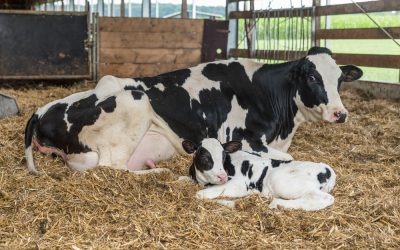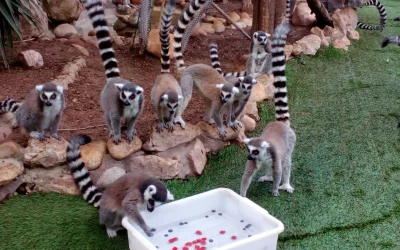M. Salas, X. Manteca
Zoos and other centres that hold wild animals in captivity face different issues that can have a direct impact on the welfare of animals. Lack of space, social stress, presence of visitors, diseases and other health problems, and medical procedures are some of the main challenges facing zoos when they want to guarantee an optimal welfare status for the animals under their care.
Visitor effect
The presence of visitors nearby the enclosure or, in some occasions, inside the facility or in close contact with the animals is a situation that animals face daily during the zoo open hours. The presence of people that are unfamiliar to the animals as well as their movements, sounds and smells, all can elicit a stress response in the animals and may negatively affect their welfare.
The stress response is driven, along with other systems, by the activation of the hypothalamic-pituitary-adrenocortical (HPA) axis. The HPA axis releases glucocorticoids such as cortisol or corticosterone as part of the endocrine mechanism for self-protection of the body in the presence of a stressor. Cortisol or its metabolites can be quantified in different matrixes such as plasma, faeces, urine and saliva, and can be used as a physiological indicator for the assessment of stress. The concentrations of cortisol or its metabolites, as well as the expression of certain behaviours have been used as indicators to assess the effect of visitor presence on animal welfare.
On some occasions, it has been suggested that visitors do not have an evident negative impact on the welfare in animals of a variety of species such as meerkats (Suricata suricatta), Kangaroo Island kangaroos (Macropus fuliginosus fuliginosus), red kangaroos (Macropus rufus), chimpanzees (Pan troglodytes), ring-tailed lemurs (Lemur catta), and crowned lemurs (Eulemur coronatus).
However, other studies have concluded that the constant presence of unfamiliar people can produce stress and have a negative impact on welfare. Specifically, an increase of abnormal behaviours has been observed as a consequence of the presence of visitors in different species such as the lion-tailed macaque (Macaca silenus) and the jaguar (Panthera onca). Also, an increase in aggressive behaviours due to visitor presence has been described in jaguar and Indian gaur (Bos gaurus gaurus).
On other occasions, an increase in vigilance and visitor-avoidance behaviours was also considered negative for the welfare of different species such as siamangs (Hylobates syndactylus), white-cheeked gibbons (Hylobates leucogenys), and African penguins (Spheniscus demersus).
Finally, other studies, such as one done with spider monkeys (Ateles geoffroyi rufiventris) and another with Indian blackbuck (Antelope cervicapra L.), have found a positive correlation between the number of visitors and the concentration of cortisol or its metabolites in different biological matrixes.
The described vigilance or alertness behaviours in some species could be interpreted as responses due to fear, but also as a form of curiosity towards visitors. In order to address this issue, some studies have complemented behavioural observations with physiological measures. For example, in a study on captive Mexican wolves (Canis lupus baileyi), the concentration of cortisol metabolites in faeces as well as some behaviours (related with posture, eating and locomotion) were assessed during days with different zoo visitor attendance. Results showed that higher visitor presence was related with changes in behaviour of the wolves and with higher levels of faecal metabolite cortisol.
However, different conclusions were reached in a study with Kangaroo Island kangaroos and red kangaroos in free-range exhibits, which determined that there was no evidence of adverse effects on the welfare of these animals due to visitors. The authors found an increase in visitor-directed vigilance behaviour when visitor numbers were higher, but there was no effect of visitor number on the distance kangaroos positioned themselves from the visitor pathway or on the faecal glucocorticoid metabolites concentration in either species. They concluded that the increase observed in visitor-directed vigilance behaviour could be due to a natural instinct to check for movements in the surrounding area, but that this behaviour may not be related to a stress response unless a real threat is detected.
The effects of visitors on behaviour and stress response of animals are variable and depend on different factors, such as the species. Also, individuals of the same species may show very different responses to the presence of visitors due to the temperament or personality and the previous experiences of each animal. Some scientists argue that the possibility that in some occasions animals might have been habituated to the presence of visitors needs to be considered.
How the visitor effect can be mitigated
Several studies suggest that the negative visitor effect could be mitigated if some measures are taken to further enrich the environment of the animal. For example, existing enclosures can be modified and improved by the addition of barriers (such as camouflage nets) and hidden spots or refuges that allow the animals to avoid visual contact with visitors.
In some species it has been suggested that when visitors observe the animals from above, their presence can be more stressful than if they are at a lower level.
The movements and noise made by zoo visitors can have an effect on the stress response of animals. Therefore, education of the visitors and the use of signs to modify visitor behaviour can decrease the negative visitor effect.
Another way to reduce the potential negative effect of visitors could be the improvement of the animals’ perceptions of unfamiliar humans by fostering positive relationships with them.
Conclusion
Zoo visitors are a factor that may be a stress source for captive animals, especially if the animals do not have any kind of control over their environment, enrichment opportunities, or if the enclosure does not have an adequate design that allows the animal to hide from the visitors’ view if it chooses to.
References
- Blaney EC and Wells DL (2004) The influence of a camouflage net barrier on the behaviour, welfare and public perceptions of zoo-housed gorillas. Animal Welfare 13: 111-118
- Carder G and Semple S (2008) Visitor effects on anxiety in two captive groups of western lowland gorillas. Applied Animal Behaviour Science 115: 211–220
- Choo Y, Todd PA and Li D (2011) Visitor effects on zoo orangutans in two novel, naturalistic enclosures. Applied Animal Behaviour Science 133: 78-86
- Davis N, Schaffner CM and Smith TE (2005) Evidence that zoo visitors influence HPA activity in spider monkeys (Ateles geoffroyii rufiventris). Applied Animal Behaviour Science 90: 131-141
- Hosey G, Melfi V and Pankhurst S (2009) Zoo animals: Behaviour, Management and Welfare. Oxford University Press, New York (USA)
- Hosey G, Melfi V, Formella I, Ward SJ, Tokarski M, Brunger D, Brice S and Hill SP (2016) Is wounding aggression in zoo-housed chimpanzees and ring-tailed lemurs related to zoo visitor numbers? Zoo Biology 35: 205-209
- Jones H, McGregor PK, Farmer HL and Baker KR (2016) The influence of visitor interaction on the behavior of captive crowned lemurs (Eulemur coronatus) and implications for welfare. Zoo Biology 35: 222-227
- Mallapur A, Sinha A and Waran N (2005) Influence of visitor presence on the behaviour of captive lion-tailed macaques (Macaca silenus) housed in Indian zoos. Applied Animal Behaviour Science 94: 341-352
- Ozella L, Favaro L, Carnovale I and Pessani D (2015) Pond use by captive African penguins (Spheniscus demersus) in an immersive exhibit adjacent to human bathers. Journal of Applied Animal Welfare Science 18: 303-309
- Pifarré M, Valdez R, González-Rebeles C, Vázquez C, Romano M and Galindo F (2012) The effect of zoo visitors on the behaviour and faecal cortisol of the Mexican wolf (Canis lupus baileyi). Applied Animal Behaviour Science 136: 57– 62
- Quadros S, Goulart VDL, Passos L, Vecci MAM and Young RJ (2014) Zoo visitor effect on mammal behaviour: Does noise matter? Applied Animal Behaviour Science 156: 78-84
- Rajagopal T, Archunan G and Sekar M (2011) Impact of zoo visitors on the fecal cortisol levels and behavior of an endangered species: Indian blackbuck (Antelope cervicapra L.). Journal of Applied Animal Welfare Science 14: 18-32
- Sekar M, Rajagopal T and Archunan G (2008) Influence of zoo visitor presence on the behavior of captive Indian gaur (Bos gaurus gaurus) in a zoological park. Journal of Applied Animal Welfare Science 11: 352-357
- Sellinger RL and Ha JC (2005) The effects of visitor density and intensity on the behavior of two captive jaguars (Panthera onca) Journal of Applied Animal Welfare Science 8: 233-244
- Sherwen SL,Hemsworth PH, Butler KL, Fanson KV and Magrath MJL (2015) Impacts of visitor number on Kangaroos housed in free-range exhibits. Zoo Biology 34: 287–295
- Sherwen SL, Harvey TJ, Magrath MJL, Butler KL, Fanson KV and Hemsworth PH (2015) Effects of visual contact with zoo visitors on black-capped capuchin welfare. Applied Animal Behaviour Science 167: 65-73
- Sherwen SL, Magrath MJL, Butler KL, Phillips CJC and Hemsworth PH (2014) A multi-enclosure study investigating the behavioural response of meerkats to zoo visitors. Applied Animal Behaviour Science 156: 70-77
- Smith KN and Kuhar CW (2010) Siamangs (Hylobates syndactylus) and white-cheeked gibbons (Hylobates leucogenys) show few behavioral differences related to zoo attendance. Journal of Applied Animal Welfare Science 13: 154-163
- Vidal LS, Guilherme FR, Silva VF, Faccio MC, Martins MM and Briani DC (2016) The effect of visitor number and spice provisioning in pacing expression by jaguars evaluated through a case study. Brazilian Journal of Biology 76: 506-510



